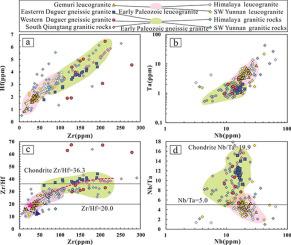当前位置:
X-MOL 学术
›
J. Asian Earth Sci.
›
论文详情
Our official English website, www.x-mol.net, welcomes your
feedback! (Note: you will need to create a separate account there.)
Early Paleozoic granitic rocks of the South Qiangtang Terrane, northern Tibetan Plateau: implications for subduction in the Proto- (Paleo-) Tethys Ocean
Journal of Asian Earth Sciences ( IF 2.7 ) Pub Date : 2020-12-01 , DOI: 10.1016/j.jseaes.2020.104579 Haitao Wang , Qingguo Zhai , Peiyuan Hu , Lingsen Zeng , Yue Tang , Zhicai Zhu
Journal of Asian Earth Sciences ( IF 2.7 ) Pub Date : 2020-12-01 , DOI: 10.1016/j.jseaes.2020.104579 Haitao Wang , Qingguo Zhai , Peiyuan Hu , Lingsen Zeng , Yue Tang , Zhicai Zhu

|
Abstract Knowledge of the early Paleozoic tectonic framework of the northern margin of Gondwana continent is critical for reconstructions of the Gondwana supercontinent. Early Paleozoic leucogranite and gneissic granite units within the South Qiangtang Terrane, northern Tibetan Plateau, can constrain the timing and geological processes that occurred along the northern margin of Gondwana continent at this time. Here, we present new field, petrological, zircon geochronological, geochemical, and Nd–Hf isotopic data for this suite of granitic rocks, and use these data to provide insights into the evolution of this Gondwanan margin. Zircon U–Pb dating yielded two groups of ages at 469–453 and 486–473 Ma. All of the granitic rocks in the Gemuri area are high-K calc-alkaline and peraluminous, and record the fractionation of variable amounts of plagioclase, K-feldspar, and biotite. These leucogranites formed from magmas generated by the dehydration melting of muscovite within Paleoproterozoic–Mesoproterozoic metapelites under relatively low-temperature conditions (TZr = 616°C–695°C). In contrast, the protoliths of the Duguer gneissic granite formed from magmas generated by the partial melting of Paleoproterozoic–Mesoproterozoic metapelites contaminated by mantle-derived material under relatively high-temperature conditions (TZr = 730°C–884°C). The coeval nature and linear distribution of the igneous rocks within the northern Gondwanan margin, and the fact that the granites in the Gemuri area are enriched in large-ion lithophile elements (LILEs; e.g., Rb and K) and depleted in high-field-strength elements (HFSEs; e.g., Zr, Nb, Ta, and Ti), suggest that this magmatism occurred in an active continental margin setting involving the formation of arc-type rocks. The presence of an early Paleozoic suprasubduction zone-type ophiolite within the South Qiangtang Terrane provides evidence of the southward subduction in the Paleo-Tethyan Ocean at this time, suggesting that the two stages (i.e., the Gemuri leucogranites and Duguer gneissic granites) of arc-type magmatism in the Gemuri area may both be related to this subduction event.
中文翻译:

青藏高原北部南羌塘地块早古生代花岗岩:对原(古)特提斯洋俯冲的意义
摘要 冈瓦纳大陆北缘早古生代构造格架的认识对于冈瓦纳超大陆的重建至关重要。青藏高原北部南羌塘地块内的早古生代淡色花岗岩和片麻质花岗岩单元可以限制此时冈瓦纳大陆北缘沿线发生的时间和地质过程。在这里,我们为这组花岗岩提供了新的野外、岩石学、锆石年代学、地球化学和 Nd-Hf 同位素数据,并使用这些数据提供了对冈瓦纳大陆边缘演化的见解。锆石 U-Pb 定年产生了两组年龄分别为 469-453 和 486-473 Ma。Gemuri地区的所有花岗岩都是高钾钙碱性和过铝质的,并记录不同数量的斜长石、钾长石和黑云母的分馏。这些暗色花岗岩由白云母在相对低温条件下(TZr = 616°C-695°C)内的古元古代-中元古代变泥质岩中脱水熔融产生的岩浆形成。相比之下,杜古尔片麻质花岗岩的原岩是由古元古代-中元古代变泥质岩在相对高温条件下(TZr = 730°C-884°C)污染的地幔衍生物质部分熔融产生的岩浆形成的。冈瓦纳北部边缘火成岩的同期性质和线性分布,以及格穆里地区花岗岩富含大离子亲石元素(LILEs;例如,Rb 和 K)并在高场-强度元素(HFSEs;例如,Zr、Nb、Ta、和 Ti),表明这种岩浆作用发生在活跃的大陆边缘环境中,涉及弧形岩石的形成。南羌塘地块内早古生代超俯冲带型蛇绿岩的存在提供了此时古特提斯洋向南俯冲的证据,表明两期(即Gemuri白质花岗岩和Duguer片麻岩) Gemuri地区的-型岩浆活动可能都与这次俯冲事件有关。
更新日期:2020-12-01
中文翻译:

青藏高原北部南羌塘地块早古生代花岗岩:对原(古)特提斯洋俯冲的意义
摘要 冈瓦纳大陆北缘早古生代构造格架的认识对于冈瓦纳超大陆的重建至关重要。青藏高原北部南羌塘地块内的早古生代淡色花岗岩和片麻质花岗岩单元可以限制此时冈瓦纳大陆北缘沿线发生的时间和地质过程。在这里,我们为这组花岗岩提供了新的野外、岩石学、锆石年代学、地球化学和 Nd-Hf 同位素数据,并使用这些数据提供了对冈瓦纳大陆边缘演化的见解。锆石 U-Pb 定年产生了两组年龄分别为 469-453 和 486-473 Ma。Gemuri地区的所有花岗岩都是高钾钙碱性和过铝质的,并记录不同数量的斜长石、钾长石和黑云母的分馏。这些暗色花岗岩由白云母在相对低温条件下(TZr = 616°C-695°C)内的古元古代-中元古代变泥质岩中脱水熔融产生的岩浆形成。相比之下,杜古尔片麻质花岗岩的原岩是由古元古代-中元古代变泥质岩在相对高温条件下(TZr = 730°C-884°C)污染的地幔衍生物质部分熔融产生的岩浆形成的。冈瓦纳北部边缘火成岩的同期性质和线性分布,以及格穆里地区花岗岩富含大离子亲石元素(LILEs;例如,Rb 和 K)并在高场-强度元素(HFSEs;例如,Zr、Nb、Ta、和 Ti),表明这种岩浆作用发生在活跃的大陆边缘环境中,涉及弧形岩石的形成。南羌塘地块内早古生代超俯冲带型蛇绿岩的存在提供了此时古特提斯洋向南俯冲的证据,表明两期(即Gemuri白质花岗岩和Duguer片麻岩) Gemuri地区的-型岩浆活动可能都与这次俯冲事件有关。











































 京公网安备 11010802027423号
京公网安备 11010802027423号